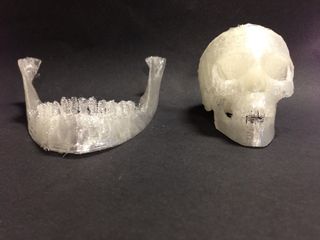How 3D Printing Can Build New Bone

Damaged bones could be fixed with a new technique that involves 3D printing a tissue using living stem cells.
For example, if a child had a jawbone defect, you could take an image of the defect, feed it into a computer and print a replacement to precisely fill the defect using the patient's own cells, said Kevin Shakeshaff, a pharmacist at the University of Nottingham in England.
"The tissues of our body are structured at the level of single cells," Shakeshaff said. "Using 3D printing, we can position cells in precise places."
The technology, which enables scientists to create a custom-fitted body part, is on display at the Royal Society’s annual Summer Science Exhibition this week in London. [7 Cool Uses of 3D Printing in Medicine]
To create the bone replacement, the 3D bioprinter creates a scaffold in the shape of the bone, and coats it with adult human stem cells, which are capable of developing into many different tissue types.
The printer's "ink" consists of a polymer called polylactic acid and a gel-like substance called alginate. The polylactic acid provides the hard, mechanical strength of bone, while the alginate acts as a cushioning material for the cells.
The printed product can be implanted in the body, where the scaffold will degrade and be replaced by new bone within about three months.
Sign up for the Live Science daily newsletter now
Get the world’s most fascinating discoveries delivered straight to your inbox.
"The first advantage is you get something in the exact shape of the defect you're trying to replace," Shakeshaff said. "More subtly, you have the ability to organize where the cells go within the scaffold," he said, adding that it leads to better blood vessel formation and ultimately better bone formation.
Previously, Shakeshaff and his colleagues developed a method of replacing bone by injecting a material that solidifies inside the body without damaging cells. Surgeons can use this as a quick fix for filling an injury. But the new 3D printing technique may offer a better solution.
At the exhibition, the team is also showing off a technique for manipulating stem cells using "laser tweezers." In the technique, two laser beams are crossed, creating an attractive force. The lasers can then pick up cells and move them around with unprecedented precision. By manipulating cells in this way, the researchers hope to understand the precise cell movements within developing human embryos.
Ultimately, these techniques may help scientists build fully functional replacements for bones or organs. The 3D printing method may be clinically available within a decade, Shakeshaff said, and the same technique could also be applied to repair more complex tissues, such as the liver or heart.
Visitors to the exhibition can try out the new techniques themselves: picking up cells using the laser tweezers, sculpting the biomaterials into structures such as veins or arteries, and printing 3D scaffolds shaped like skulls and other bones.
The Royal Society hosts the Summer Science Exhibition every year to display advanced science and engineering research from throughout the United Kingdom.
Follow Tanya Lewis on Twitter and Google+. Follow us @livescience, Facebook & Google+. Original article on Live Science.

Most Popular


